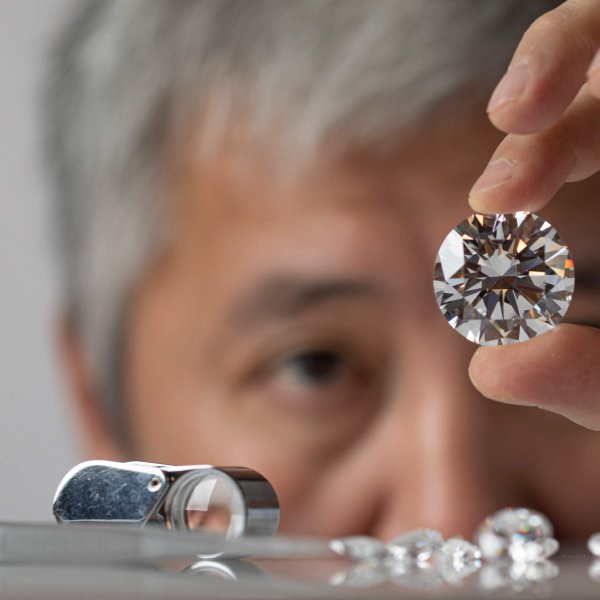When it comes to purchasing a diamond, the process can often feel overwhelming, especially for beginners who are unfamiliar with the intricate world of gemstones.
With terms like carat, cut, color, and clarity flying around, it's easy to get lost in a sea of information. Fear not, for this comprehensive guide is here to demystify the diamond buying process and break down the essential aspects that contribute to a diamond's quality and value.

Carat: The Weight and Size
Carat is a term frequently associated with diamonds, and it refers to the diamond's weight, not its size. One carat is equivalent to 200 milligrams, and as the carat weight increases, so does the diamond's rarity and, usually, its price. However, it's crucial to note that carat weight alone doesn't determine a diamond's value – the other three Cs also play significant roles.
While a larger carat diamond might catch the eye, it's important to consider personal preferences and how well the carat weight complements the other aspects of the diamond. A slightly smaller diamond with exceptional cut, color, and clarity might appear more brilliant and desirable than a larger one lacking these qualities.
Cut: The Sparkling Symmetry
The cut of a diamond directly impacts its brilliance and sparkle, arguably making it the most important of the 4 Cs. A well-cut diamond reflects light in a way that enhances its internal fire and radiance. The cut grade is usually categorized as Excellent, Very Good, Good, Fair, and Poor.
The cut isn't just about the diamond's shape; it encompasses the symmetry, proportions, and facets that work together to create its brilliance. The classic round brilliant cut is popular for its ideal arrangement of facets, but other shapes like princess, emerald, and pear cuts offer unique characteristics.
Color: The Subtle Spectrum
Diamond color refers to the presence or absence of color in a white diamond. The Gemological Institute of America (GIA) grades diamond color on a scale from D (colorless) to Z (light yellow or brown). The less color a diamond has, the more valuable it tends to be.
Color differences can often be quite subtle and challenging to discern for the untrained eye. However, even a slight variation in color grade can impact the diamond's price. It's important to strike a balance between color and budget, as a diamond with a near-colorless grade can often appear just as stunning as a colorless one but at a more affordable price point.
Clarity: The Window to Perfection
Diamonds are formed deep within the Earth's mantle, and their journey can result in natural imperfections called inclusions and blemishes. Clarity refers to the presence of these imperfections under 10x magnification. The GIA's clarity scale ranges from Flawless (no inclusions or blemishes visible under magnification) to Included (inclusions visible to the naked eye).
While a flawless diamond might seem like the ultimate choice, many diamonds with slightly lower clarity grades can appear just as stunning to the naked eye without the hefty price tag. It's essential to find a balance between clarity and budget, considering that most small inclusions won't affect the diamond's overall beauty or durability.

Understanding the Interplay of the 4 Cs
Now that we've dissected each of the 4 Cs, it's crucial to recognize their interplay in determining a diamond's overall quality and value. A diamond's beauty arises from the harmonious interaction of these four aspects. The challenge for buyers is finding the right balance among them based on personal preferences and budget constraints.
For instance, if size is a priority, you might opt for a diamond with a slightly lower color grade or clarity but a well-cut, brilliant appearance. On the other hand, if you value exceptional brilliance and sparkle, focusing on cut and color might be more important than carat weight.
Ultimately, the goal is to strike a balance that results in a diamond that visually appeals to you and meets your desired level of quality. This balance might differ from person to person, as everyone has unique tastes and preferences.

Conclusion: Your Journey into Diamond Buying
Demystifying the diamond buying process involves understanding the 4 Cs – carat, cut, color, and clarity – and how they work together to determine a diamond's quality and value. By breaking down these aspects and their significance, you can navigate the world of diamond purchasing with confidence.
Remember, each diamond is a unique masterpiece, and the right choice depends on your personal preferences and budget. Whether you prioritize size, brilliance, colorlessness, or a combination of factors, the key is to strike a balance that resonates with you. Armed with this knowledge, you're now better prepared to embark on your journey to find the perfect diamond that symbolizes your special moments for years to come.










